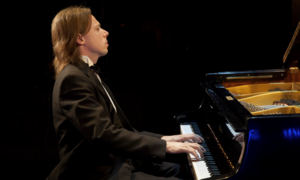Reynolds Theater at Duke was packed on Friday, April 30, for the first of two nights of performances by Atlanta’s Ballethnic Dance Company. The Leopard’s Tale, a two-act piece with prologue, libation and blessing, was danced by the company, with considerable augmentation from the Triangle. Several dancers from Chuck Davis’s African-American Dance Ensemble and a number of musicians as well as dozens of children and young people joined the Ballethnic troupe on stage for a unique combination of African and ballet dancing.
That this was an audience more used to the joyous ways of community-connected African dancing than to the more decorous protocols of ballet theater was evident from the moment the libation-offering elder called out the ritual greeting and received a thundering audience response. Even the small white minority in the audience knew the drill, having been well-trained by Chuck Davis, who allows no one to remain silent. Ballethnic chose the perfect town to which to bring its ambitious, audacious, accomplished and amazing art.
The Leopard’s Tale, a remarkably unsentimental story of life and death in an African jungle and village, was choreographed by Ballethnic co-founder and co-artistic director Waverly T. Lucas II (who danced a snake and the chief warrior), and set to percussion music by L. Gerard Reid. While we did see a full range of village people in the second act, all the characters in the first act were animals: leopard, leopardess, and leopard kittens, gazelles, zebras, lions, vultures, wild dogs and hyenas, monkeys, and snakes. Every costume was fantastic. I especially liked the gazelles, whose toe shoes were painted to look like hooves.
While the spectacle was grand, it was the dancing that was most important. It was less about line and image than about motion and emotion. I was irresistibly reminded of the 1998 Warren Beatty movie Bulworth , in which a US Senator who thinks he’s going to die goes off the rails and starts telling the truth, insisting that the only way we can get over our racial problems in America is for everyone to start blending – mating with the “other,” doing what in the bad old days used to be called miscegenation. There’s a great scene where Beatty is taken by Halle Berry to an after-hours club in South-Central LA, learns how dance hip-hop, starts talking in rapping rhyme, and decides to live. Something related happens when the exquisite discipline of ballet is injected with the postures and rhythms of African dance. The blending of cultures removes nothing from either but instead adds to both. Ballet is brought closer to the earth, and the African dance leaps into the ethereal realm.
One is used to seeing the African style danced bare-footed and flat-footed, so perhaps the most surprising thing about this performance was how natural it seemed to see a dancer go through a series of African postures and motions and then go up on pointe – or to do the entire sequence on pointe. The dancers’ sheer physical prowess, which allowed them to dance lengthy passages on their toes while cantilevering their bodies far from the axis of balance, was hardly short of Olympian. In this they were led by company co-founder and co-artistic director Nena Gilreath, whom we can proudly claim as a graduate of the North Carolina School of the Arts. Gilreath danced the Leopardess on Friday night, and a snake, and returned in the second act as a priestess – a dazzling turn for which she should have received a boatload of flowers. Also particularly beautiful in her dancing was Ballethnic newcomer Dana Marie Ingraham.
Equally impressive, if not quite as accomplished, were the fifty-odd young dancers who had been chosen at audition to take part in this production. They proved themselves through months of rehearsals to be committed to the art. All, from the tiniest children to the teenagers, knew their steps, knew their spacing, knew their entrances and exits. They became their animals. The wild dogs were really great. But best of all, they had the rhythm and were knowing the joy of dancing – you could see it beam from their faces. It was very beautiful to see the professionals encouraging the children and sharing the glory with them in the final scenes.
While the dancing was deeply impressive, there were a few weaknesses in the overall production. The show began with drummers descending through the auditorium to the stage, to be joined by singers. The audience got revved up – but the appearance of the elder and his too-long explanation of what he was doing really dragged things down. And then the drummers went away, the lights went down, and a disembodied voice went into an unnecessary long synopsis of the action to come. During the first act there was no live drumming, only recorded sound. Consequently, the first act was a little flat. The choreography was certainly inventive, but it did not fully activate the stage space. Partly due to the design of the scenery, the dancers were constrained to move in patterns mostly parallel or perpendicular to the proscenium.
The second act, with powerful drummers on stage, erased the irritations of the slow start. It was a marvelous event, and I hope it encourages further similar collaborations among its producer, the St. Joseph’s Historic Foundation, the Duke Institute of the Arts, and the National Performance Network. This kind of blending can do us all good.











